#since 1844
Explore tagged Tumblr posts
Text


Had a great time visiting Milwaukee for my Birthday!
I didn't take as many photos as I thought I would, but it's just enough to get a mini zine out of it.
Read the full story on Patreon:
#travel photography#pabst#pbr#hipster aesthetic#milwaukee beer#milwaukee#wisconsin#winter#birthday trip#behind the scenes#patreon rewards#travel reviews#experiences#mini zine#favorite beer#americana#since 1844#best beer#best place#cameraslinger#shoot with heart#travel vicariously
1 note
·
View note
Text
I came here sure I could find any guys obsessing over any piece of fiction....why Is no one talking about The count of Montecristo? Like, there's a new movie too! Don't let me obsess alone over a few thousands year old book
#the count of monte cristo#listen i know some part of the book are racist and very problematic but are you don't come at me and look the history of france in 1844#but i love a good revenge#and even if the disguises are silly#boy do i love this book#really#it has been a long time since i loved a classic this much#last was Pinocchio and I am talking about Collodi 's weird original one I love that weird crazy story#reblogging
9 notes
·
View notes
Text


"It is something of a primitive survival insssstinct," Pentious explains.
He reaches for Fitzgerald, cooing and soothing her as he lifts her for the first time since she emerged from her shell. She doesn't protest getting lifted, especially as Pentious holds her close and starts to rock her, tilting her little body up and down and side by side. He makes little faces and sounds accompanying the movements, making the first-ever giggle escape the new minion.
"In a few seconds, I will pretend to drop her," Pentious continues in the same sing-songy voice, making sure Fitzgerald is none the wiser. "She should reach upwards, if her reflexes are up to par."
Pentious continues the little game for a little before he turns away from the table and brings the end of his tail to hover below Fitzgerald. He hums the melody to Humpty Dumpty in a bit of macabre humour before suddenly loosening his grip from around the little gal.
Fitzgerald reaches up and around herself with little fingers spread and feet kicking, a surprised expression over her features. But within the same half a second, Pentious catches her in his tail and resumes rocking, as if nothing had happened at all. The nonchalance makes Fitzgerald forget the moment too, and she resumes giggling along.
"Beautiful!" Pentious remarks, relieved. He turns to Alastor, still rocking the egg and smiling lovingly.
"Your turn, Gigglemug. But no more moro, worry not! Hold out your hands for her. Let's see if she will move towards you."

"The what."
No, Alastor knows nothing of the sort, too invested in the other's little parental movements that he finds to be all too endearing - and the shortened version of the name is quite adorable, as well - to think very hard about what a small little egg creature might need to consistently function in such a body; in such an environment.
Also - does Pentious make all those shoes...?
But back to the point.
"What is that?" He asks, seeking clarity. Startling? Do they need to explain the fabric of Hell and what, exactly, that means in the grand scheme? Or does Pentious have something else in mind?
62 notes
·
View notes
Text
was thinking about this

To be in "public", you must be a consumer or a laborer.
About control of peoples' movement in space/place. Since the beginning.
"Vagrancy" of 1830s-onward Britain, people criminalized for being outside without being a laborer.
Breaking laws resulted in being sentenced to coerced debtor/convict labor. Coinciding with the 1830-ish climax of the Industrial Revolution and the land enclosure acts (factory labor, poverty, etc., increase), the Metropolitan Police Act of 1829 establishes full-time police institution(s) in London. The "Workhouse Act" aka "Poor Law Amendment Act of 1834" forced poor people to work for a minimum number of hours every day. The Irish Constabulary of 1837 sets up a national policing force and the County Police Act of 1839 allows justices of the peace across England to establish policing institutions in their counties (New York City gets a police department in 1844). The major expansion of the "Vagrancy Act" of 1838 made "joblessness" a crime and enhanced its punishment. (Coincidentally, the law's date of royal assent was 27 July 1838, just 5 days before the British government was scheduled to allow fuller emancipation of its technical legal abolition of slavery in the British Caribbean on 1 August 1838.)
---
"Vagrancy" of 1860s-onward United States, people criminalized for being outside while Black.
Widespread emancipation after slavery abolition in 1865 rapidly followed by the outlawing of loitering which de facto outlawed existing as Black in public. Inability to afford fines results in being sentenced to forced labor by working on chain gangs or prisons farms, some built atop plantations.
---
"Vagrancy" of 1870s-onward across empires, people criminalized for being outside while being "foreign" and also being poor generally.
Especially from 1880-ish to 1918-ish, this was an age of widespread mass movement of peoples due to the land dispossession, poverty, and famine induced by global colonial extraction and "market expansion" (Scramble for Africa, US "American West", nation-building, conquering "frontiers"), as agricultural "revolutions" of imperial monoculture cash crop extraction resulted in ecological degradation, and as major imperial infrastructure building projects required a lot of vulnerable "mobile" labor. This coincides with and is facilitated by new railroad networks and telegraphs, leading to imperial implementation or expansion of identity documents, strict work contracts, passports, immigration surveillance, and border checkpoints.
All of this in just a few short years: In 1877, British administrators in India develop what would become the Henry Classification System of taking and keeping fingerprints for use in binding colonial Indians to legal contracts. That same year during the 1877 Great Railroad Strike, and in response to white anxiety about Black residents coming to the city during Great Migration, Chicago's policing institutions exponentially expand surveillance and pioneer "intelligence card" registers for tracking labor union organizing and Black movement, as Chicago's experiments become adopted by US military and expanded nationwide, later used by US forces monitoring dissent in colonial Philippines and Cuba. Japan based its 1880 Penal Code anti-vagrancy statutes on French models, and introduced "koseki" register to track poor/vagrant domestic citizens as Tokyo's Governor Matsuda segregates classes, and the nation introduces "modern police forces". In 1882, the United States passes the Chinese Exclusion Act. In 1884, the Ottoman government enacts major "Passport Nizamnamesi" legislation requiring passports. In 1885, the racist expulsion of the "Tacoma riot".
Punished for being Algerian in France. Punished for being Chinese in San Francisco. Punished for being Korean in Japan. Punished for crossing Ottoman borders without correct paperwork. Arrested for whatever, then sent to do convict labor. A poor person in the Punjab, starving during a catastrophic famine, might be coerced into a work contract by British authorities. They will have to travel, shipped off to build a railroad. But now they have to work. Now they are bound. They will be punished for being Punjabi and trying to walk away from Britain's tea plantations in Assam or Britain's rubber plantations in Malaya.
Mobility and confinement, the empire manipulates each.
---
"Vagrancy" amidst all of this, people also criminalized for being outside while "unsightly" and merely even superficially appearing to be poor. San Francisco introduced the notorious "ugly law" in 1867, making it illegal for "any person, who is diseased, maimed, mutilated or deformed in any way, so as to be an unsightly or disgusting object, to expose himself or herself to public view". Today, if you walk into a building looking a little "weird" (poor, Black, ill, disabled, etc.), you are given seething spiteful glares and asked to leave. De facto criminalized for simply going for a stroll without downloading the coffee shop's exclusive menu app.
Too ill, too poor, too exhausted, too indebted to move, you are trapped. Physical barriers (borders), legal barriers (identity documents), financial barriers (debt). "Vagrancy" everywhere in the United States, a combination of all of the above. "Vagrancy" since at least early nineteenth century Europe. About the control of movement through and access to space/place. Concretizing and weaponizing caste, corralling people, anchoring them in place, extracting their wealth and labor.
You are permitted to exist only as a paying customer or an employee.
#get to work or else you will be put to work#sorry#intimacies of four continents#tidalectics#abolition
3K notes
·
View notes
Text
not a reviewer saying they "added a lesbian" to the count of monte cristo... my girl eugénie has been there since 1844
432 notes
·
View notes
Text
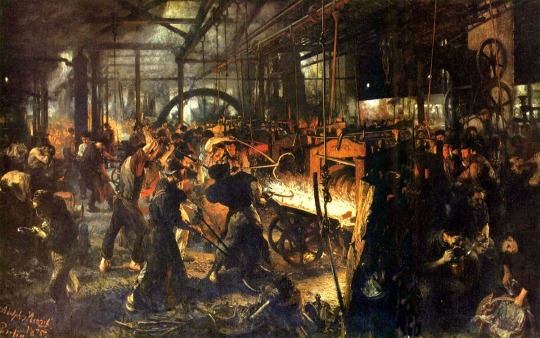

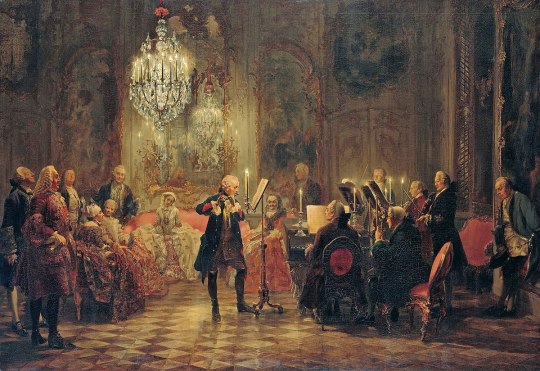
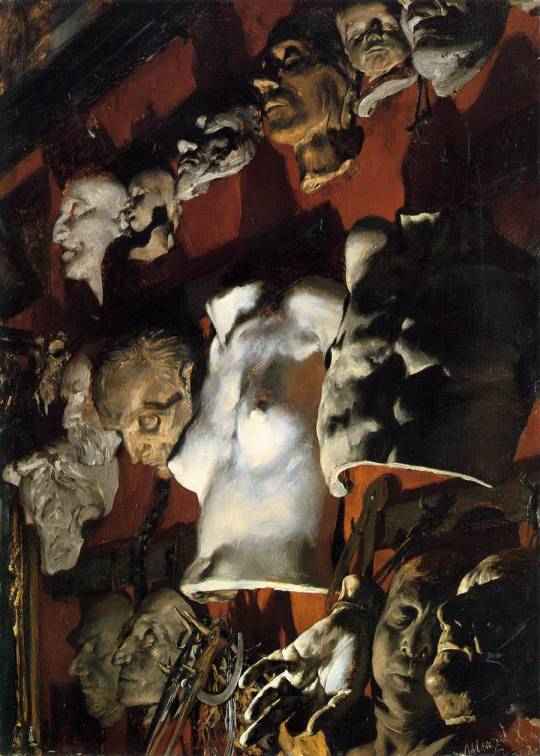
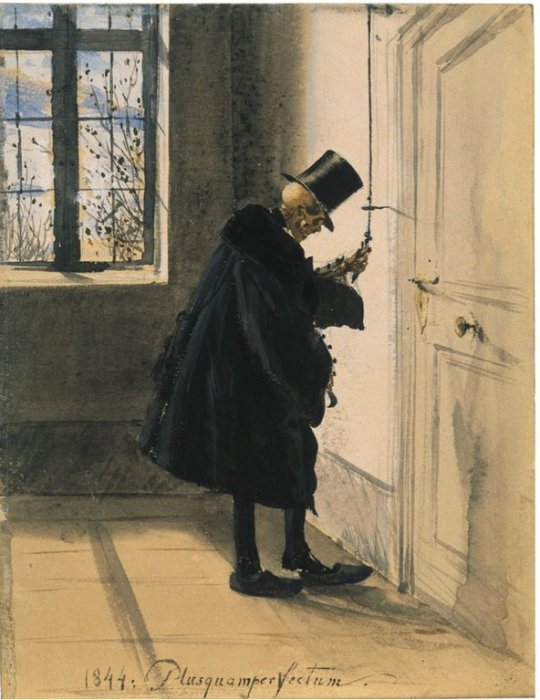
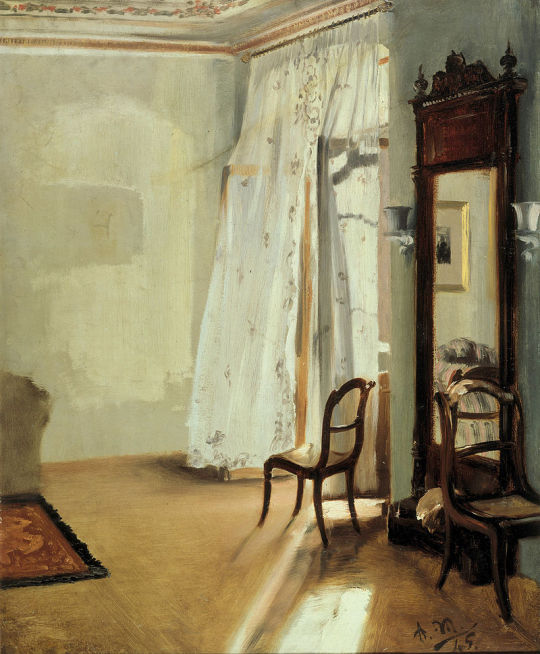
THE QUEST FOR REALITY; ADOLPH VON MENZEL
Adolph von Menzel (1815-1905) was a German painter and printmaker who portrayed life in 19th-century Prussia, historical events, and everyday scenes. He was largely self-taught, and his skills developed practically through lithography and drawing experience.
The Iron Rolling Mill, 1875
This painting captures the intense labour of steelworkers in a Prussian industrial mill. There is a detailed expression, both of the machinery and the workers, illustrating the social condition of working-class people during the Industrial Revolution and Menzel's turn from historical themes to contemporary issues.
The Dinner at the Ball, 1878
It is a portrayal of an elegant high-society scene, coupled with detailed portrayals of fashionable guests and luxurious surroundings, all of which bring out the Biedermeier style. It captures the 19th-century social life, proving Menzel's skill to render social dynamics and intimate moments.
Frederick the Great Playing the Flute at Sanssouci, 1852
It portrays the tranquil scene of Frederick II music-making in his palace. The painting showcases Frederick's dual character as a ruler and as a musician, evincing cultural sophistication and the opulence of his court. The composition is the epitome of Menzel's great admiration for Frederick and his commitment to a history of Prussia done with emotional depth and realism.
Studio Wall, 1872
Menzel painted a nighttime view of his studio wall, with illuminated plaster casts, including death masks and classical figures. This work highlights Menzel's thoughts at the time; he had been ruminating over life and death and artistic posterity. It was a touching memorial to his friend Friedrich Eggers as well as a strong demonstration of his mastery of dramatic lighting.
The Visit From Death, 1844
Death is depicted as a humble professional who is neither wrathful nor unkind. Just simply doing its job and has no ill will for those it visits upon. It even has a sense of respect, taking its clogs off before entering the home. Menzel followed up in 1845 with a hilarious painting that suggests that the arrival of Death isn’t so final after all!
The Balcony Room (1845)
Inspired by his journeys to Paris, Menzel depicts a sparsely furnished apartment full of sunlight. This painting foreshadows impressionist techniques since it's totally oriented with light and atmosphere, marking an important turn in Menzel's career away from historical themes and toward contemporary genre scenes.
141 notes
·
View notes
Photo

Pirate Havens in the Golden Age of Piracy
The buccaneers who roamed the Spanish Main and the pirates who plundered the Caribbean and the Indian Ocean during the Golden Age of Piracy (1690-1730) needed a place of refuge where they could share out and enjoy their loot. Pirate havens like Port Royal on Jamaica, Tortuga on Hispaniola, and New Providence in the Bahamas provided safe harbours, the possibility to sell looted cargo to crooked traders, and were within easy reach of the main shipping routes. As the colonial authorities finally got a grip on piracy from 1720 onwards, so the pirate havens declined, many of them becoming a pirate’s very last port of call: the place of their execution.
The Lure of the Pirate Dens
Pirates needed safe harbours where they could hide from the authorities and share out their loot. Ideally, a base was close to the routes taken by merchant shipping, the pirates’ primary target, and, even better, close to a strait where these ships were obliged to navigate through. It also needed to be a place of refuge during the winter or storm season. Pirates needed to be able to repair their ships, and so a base with shallows was ideal as a vessel could be more easily careened. Such locations had the added advantage that large naval vessels could not easily access them.
The havens were a safe place for pirates to rest their weary sea legs and let their hair down. Here they quickly spent their ill-gotten loot on wine, women, and gambling. Pirates sold captured cargoes to unscrupulous dealers who had set up business in the various pirate havens in the Caribbean and the Indian Ocean. The dealers were on to a good thing since they acquired goods at a much cheaper rate than from legitimate merchant vessels in any other port, and the pirates were happy enough to get their cash, even if they were obliged to sell at a price much below the real value. The dealers then smuggled their dubious goods into legitimate ports where it was sold through the channels it would have reached if the pirates had not interrupted the trade process.
Pirates struck deals with corrupt colonial officials if they could, getting a better price for their plunder than they would have in a haven. Perhaps the most infamous of the rotten governors was Charles Eden, governor of North Carolina, who gave such notorious and unrepentant pirates as Edward Teach (aka Blackbeard, d. 1718) and Stede Bonnet (d. 1718) pardons, even allowing the former to establish a pirate base at Ocracoke Island. Another infamous governor who fenced loot for pirates was Colonel Benjamin Fletcher in New York before his dismissal in 1698.
Continue reading...
105 notes
·
View notes
Text
A Million Dreams

Pairing(s): Eddie Brock x Brock!Reader, slight mention!Eddie Brock x Anne
Warnings: definitely hints of sibling incest, hurt/comfort, wrote this when i realized becoming a veterinarian wasn't for me :(, late night conversations
Words: 1844
Summary: You couldn't tell Eddie and Anne the truth. You were a loser.
a/n: found this while going through my ao3 since I heard it might be shut down in 2025? 😥

“(y/n). . .”
Shame, guilt, and a plethora of other emotions were pinned into you. Your backpack hung heavy on your back and your eyes burned at the light filtering from inside of Eddie’s apartment. You had debated on running to your brother for help. Neither of you had seen each other for years. Both focusing on your careers. There was nowhere left for you to go. Initially you had gone to the address Anne had given you a couple of years ago only to find out that he no longer lived there and that they were no longer together. How were you supposed to know any of this? You didn’t blame Eddie for lack of communication. You blamed yourself mostly, you hadn’t bothered to contact him. Life had made you busy. Vet school had made it nearly impossible for you to have a personal life.
Fingers curling around the strap of your bag your teeth work on your bottom lip anxiously. “Hey Ed.”
His dark gray eyes continue to gawk at you as he leaves his mouth wide open. Stuttering incoherently as he continues to stand in the doorway. You’d have to start the conversation.
“It’s been a while hasn’t it? Maybe five years? Um. . . Sorry to show up all of a sudden. . .”
Finally collecting himself, Eddie steps aside. “C-Come in.” He quickly goes about trying to tidy his small apartment as best as he can while he rambles to himself.
You sat down on the closest thing that looked comfy. Which just happened to be a dingy couch that had several stains on it.
It felt like heaven the moment your back hit the cushions. True your trip hadn’t been that long. The distance from UC Davis to San Francisco wasn’t that long of a stretch but it was still utterly straining on you.
Exhaustion swallowed you whole.

She was out like a light the moment she sat down on his couch.
Eddie was confused at what was going on. His sister suddenly showing up after years without talking and without an explanation. Eddie dare not wake her up though. (y/n) looked so drained the moment he had opened his door.
“(y/n) looks delicious.”
“Dude, we’ve been over this. No eating good people. Especially not my sister.” Eddie scowls at his symbiote companion. Venom already knew all about (y/n) as he knew everything about Eddie since he attached himself to him.
“But even you want to take a bite. I’ve seen your thoughts.” Venom points out yet again of the fact that he resided inside of Eddie and shared his thoughts and memories.
Internally swatting at his parasite, Eddie shakes his head. “I don’t know what you’re talking about. She’s my little sister.”
Venom seems to laugh at that. “You seem to like her the way you like Anne. I’m taking from your continued denial that it isn’t normal. You can’t hide things from me Eddie. I feel everything you do. I can hear your thoughts and see your dreams. I can look into your past.”
Silent as he glances over at his dozing sister, he simply tells Venom “We just used to be close when we were little. Or rather when she was little.” What was she doing there? The last time he had heard from her was right before he had been forced to leave New York. She had been living in California for some time already back then and had mostly been keeping in touch with Anne considering she lived in San Francisco. (y/n) had been going to school to become a veterinarian. It had been her dream since she was little. She’d bring home stray animals and nurse them back to health until their parents would catch on and force her to give them up.
“Sweet inside and out.” Venom cackles.
Ignoring him, Eddie grabs a blanket from his bed and drapes it over (y/n). He would get answers in the morning.
The investigator in him though wanted them right away though. He’s immediately dialing Anne’s number. There was no other way that (y/n) would know where he lived.
“I’m guessing (y/n) made her way safely to your place?” Immediately came Anne’s voice.
“Yeah. She’s passed out on my couch. Didn’t really get a chance to explain why she’s here. I was hoping you could fill me in until she wakes up.”
He could practically hear Anne roll her eyes. “Typical Eddie. You don’t even have patience when it comes to your own sister. Just wait until she wakes up. It’s best you hear it from her.”
Anxiety twisted his gut and made Venom spike with anticipation and apprehension. “What happened? Is it bad?”
“. . . Well it’s not exactly good. . .” sighed Anne. “I really think you should wait for her to tell you, Eddie. It’s not my place to say.”
“Tell us!” Venom separates himself from Eddie only to form a head that he could talk through. The foreign sound of Venom’s voice has (y/n) stirring on the couch. They both hold their breath and watch her, waiting to see if she would wake up.
“Like I said, wait until she wakes up. I really don’t want to break (y/n)’s trust.” With that, Anne hangs up leaving Eddie to think of the worst scenarios. What happened to his sister to make her seek him out? Last he heard she was doing fine in vet school. Did someone hurt her? She was living by herself.
All sorts of questions swarmed his mind like a horde of pissed off hornets. Eddie would have to find some way to calm himself down enough so that he could sleep.

You don’t know how long you had been out but when your eyes blinked open you see all the lights turned off and your brother out of sight. There was a blanket on top of you that kept you pressed against the couch, trying to keep you in sleep’s sweet embrace. You couldn’t continue to sleep though. Not with so many secrets that were caked onto your heart.
Lazily you set your feet down on the floor and force yourself to stand. Squinting your eyes you attempt to focus them in the dark and try to find your brother’s bedroom. Nostalgia hits you. How many times had you done the very same thing when you were little? You would crawl into Eddie’s bed, snuggling against him and making him wake up so that you could talk his ear off until you fell back asleep. He never got mad at you when you did this. Any other sibling would, but not Eddie. He was always so much more patient with you than any of your friends’ older siblings. Their older brother or sister wanted nothing more than for them to stay out of their way. Eddie had played a very important role during your childhood. Always caring for you even more so than yoru own parents did. Even helping you hide the stray animals you would find.
The moment your foot passes through the doorway Eddie was already sitting up groggily in his bed. As if he had already felt your presence. He rubs at his eyes and mumbles out your name.
Silently you move to the other side of his bed and peel his blanket away so you could slip in. He scoots over obligingly.
“I’m sorry I showed up all of a sudden.”
“S’okay. But what are you doing here? I mean, not that I’m not happy to see you. Don’t get me wrong, I am. It’s just. . . You know, been a while. . .”
“Do you remember all the things we’d talk about late at night when we were little? All the things we dreamed of for the future.” You stare up at his ceiling. In your childhood room the two of you had gotten the glow in the dark stars and stuck them on your own ceiling. “Even back then you wanted to be an investigator. A weird career for a kid to want.”
You could hear the smile in his voice. “Yeah. And you always wanted to help animals and be a vet back then.”
“A million dreams that kept us awake. Dreams that we were so hopeful in.” You felt your eyes burn as the onslaught of tears creeped up on you.
Eddie shifts next to you. “Hey, what’s wrong?”
You cover your face with your hands and try not to sob out loud. “I failed vet school Ed.”
“What? But Anne told me you were doing so well.”
A soft cry escapes your lips much to your horror. You turn your back to him so that you could somewhat cry without peering eyes. “How could I tell her the truth?! The both of you have successful jobs! I’m just. . . I’m just a fucking loser Eddie! I tried so hard! It doesn’t matter how much you want something. Even when you work so hard for it. . .”
“Hey, don’t talk like that about my sister!” Eddie growls and rolls you over to your other side. “You are not a loser. I’m the only loser in this family, okay? Is that why you haven’t called me? Were you ashamed?”
Nodding you sniffle a little. “I tried so hard Ed.”
One of his massive arms wraps around you and pulls you closer to his barrel chest. “I know (y/n). I know.”
“I wanted to be a vet so bad. But the lessons weren’t sinking in. I didn’t understand anything no matter how hard I studied. A-and. . .” You take a deep breath, nails digging into your brother’s back as you desperately cling to him. “The idea of having to put animals down. . .” Another cry clawed it’s way up your throat. “I’m so weak. I couldn’t do it. I can’t do it. It would’ve never worked out. I have no idea what I’m gonna do with my life. . . I’m already (age). I’ve wasted so many years of my life.”
His lips press against the crown of your head. “Listen to me (y/n). Even if you shoot for the moon and miss you’ll still land on the stars.”
You shake your head. “What stars? I missed the moon entirely and landed into a void.”
“You’ll feel like that now. But once you take a few deep breaths you’ll find the stars. We’ll find the stars. I’ll help you get back on your feet. You’re a brilliant girl (y/n). Don’t let this burn you out. You’re still so young.” Eddie’s calm voice soothes you immensely that the pang in your chest numbed considerably which allowed the tears to stop flowing.
Gazing up at him with still watery eyes you ask “What am I gonna do now Eddie?”
“We’ll figure that out in the morning. For now let’s sleep. You deserve that much.”
You wouldn’t argue with that. At least now you were able to sleep with a somewhat clear mind. Just as long as Eddie stayed beside you. You would dream of a million more dreams.
#reader insert#reader insert fanfiction#marvel mcu#mcu reader insert#mcu venom#mcu eddie brock#mcu fanfic#mcu fandom#marvel cinematic universe#marvel x reader#marvel fanfiction#eddie brock x reader#eddie brock#venom symbiote
63 notes
·
View notes
Text
10 Rules for Writers by Nietzsche

Between August 8 and August 24 of 1882, Friedrich Nietzsche (October 15, 1844–August 25, 1900) set down ten stylistic rules of writing in a series of letters to the Russian-born writer, intellectual, and psychoanalyst Lou Andreas-Salomé — the first female psychoanalyst.

Smitten with 21-year-old Andreas-Salomé, Nietzsche decided to make her not only his intellectual protégé, but also his wife, allegedly proposing marriage at only their second meeting earlier that year. Despite Andreas-Salomé’s rejection of his romantic advances and the subsequent break in the friendship, she retained a lifelong respect for his mind and work.
Collected under the heading “Toward the Teaching of Style”:
Of prime necessity is life: a style should live.
Style should be suited to the specific person with whom you wish to communicate. (The law of mutual relation.)
First, one must determine precisely “what-and-what do I wish to say and present,” before you may write. Writing must be mimicry.
Since the writer lacks many of the speaker’s means, he must in general have for his model a very expressive kind of presentation of necessity, the written copy will appear much paler.
The richness of life reveals itself through a richness of gestures. One must learn to feel everything — the length and retarding of sentences, interpunctuations, the choice of words, the pausing, the sequence of arguments — like gestures.
Be careful with periods! Only those people who also have long duration of breath while speaking are entitled to periods. With most people, the period is a matter of affectation.
Style ought to prove that one believes in an idea; not only that one thinks it but also feels it.
The more abstract a truth which one wishes to teach, the more one must first entice the senses.
Strategy on the part of the good writer of prose consists of choosing his means for stepping close to poetry but never stepping into it.
It is not good manners or clever to deprive one’s reader of the most obvious objections. It is very good manners and very clever to leave it to one’s reader alone to pronounce the ultimate quintessence of our wisdom.
#friedrich nietzsche#nietzche#lou andreas salome#writing tips#writing advice#on writing#writeblr#writing prompt#writers on tumblr#poets on tumblr#spilled ink#dark academia#poetry#writing reference#literature#light academia#writing inspiration#writing inspo#writing ideas#creative writing#writing resources
79 notes
·
View notes
Text

Yay I finished this Anidala piece, I think I liked it better unfinished but hey, I least I practiced. The reference is the sculpture Paolo e Virgina, by the Italian sculptor Alessandro Puttinati. It was such a coincidence I chose this piece, since the characters are childhood friends who fall in love but then after the tragic death of Virginia, Paolo dies from pure sorrow. Sounds familiar?
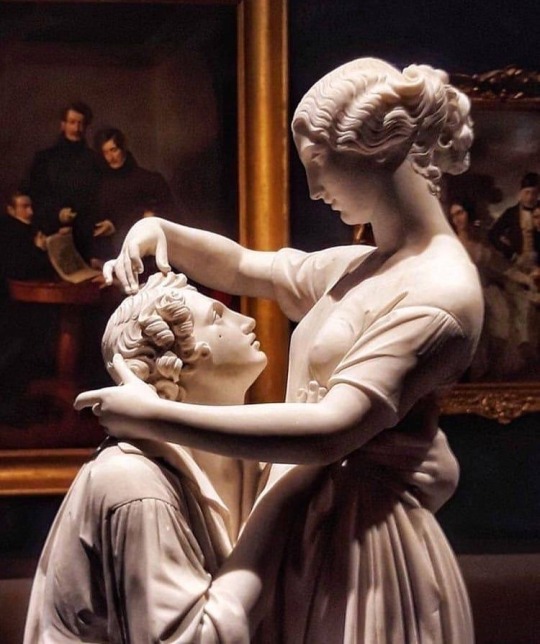
Alessandro Puttinati, Paolo e Virginia, 1844
#anakin skywalker#star wars fanart#anidala#star wars padme#padme amidala#anakin x padme#anakin#star wars#star wars art#my art uwu
809 notes
·
View notes
Text
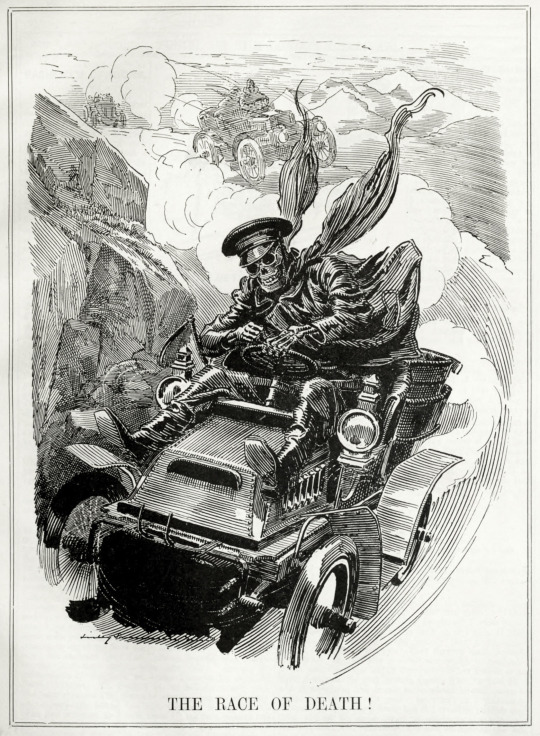
Edward Linley Sambourne (1844-1910), 'The Race of Death', ''Punch'', June 3, 1903
Source
I'm very much in the "anti-car culture" camp and find cars to be one of the worst aspects of living in any city (especially in Philly in the summer). It seems early cartoonists often depicted cars as machines of death around their general introduction into our shared public spaces. (I've amassed a rather large collection of these anti-car cartoons, this one from Punch being just one example.) Here's some car facts from a recent study from the Journal of Transport Geography: 1) 1 in 34 deaths are caused by cars and automobility with 1,670,000 deaths per year 2) Cars and automobility have killed 60–80 million people since their invention
#Edward Linley Sambourne#english artists#cartoonists#punch#punch magazine#vintage illustration#vintage art#fuck car culture#anti-car culture#I don't like cars#Give us robust public transportation
165 notes
·
View notes
Text

I decided to do a redraw of the Doctors as vampires bc I'm unwell about the concept <3 individual crops and also their names and stuff under the cut. 15 is gonna get his own drawing eventually since we weren't up to him yet when I first drew this





9: Dorian. He/him. Born in 1844. 109 years old. Turned at 42. 7'
10: Ezra. He/they. Born in 1743. 210 years old. Turned at 36. 7'4"
11: Austen. He/she/they. Born in 1733. 220 years old. Turned at 29. 7'2"
12: Judas. She/they. Turned in 1641. 312 years old. Turned at 62. 7'
13" Charlotte (Charlie for short). He/she. Born in 1440. 513 years old. Turned at 39. 6"9'
#yes they're all tall as fuck these vampires were inspired by dimitrescu what do u want from me#my art#digital art#fanart#dr who#doctor who#dr who AU#vampire#ninth doctor#9th doctor#tenth doctor#10th doctor#eleventh doctor#11th doctor#12th doctor#twelfth doctor#13th doctor#thirteenth doctor
65 notes
·
View notes
Note
Scalding HOT tea, part 1. Friend of mine is acquaintances with British journalists who finally told my friend some very interesting tea. British intelligence informed QE2 several weeks before Princess Eugene's wedding in 2018 that M was not pregnant with A. Not long after, major British newspaper editors were summoned to a meeting with QE2 in the 1844 Room at Buckingham Palace. The British press has been silent on the fake pregnancies since then.
From 4 days ago
Hi Nonny,
Thank you for the hot tea. :) That does sound like the press was stopped from releasing the story. I wonder why?
The outcome of the story being confirmed is that Harry would be guilty of attempting to interfere in the Line of Succession, and the penalty by law for that is for Harry and his children to lose their places in the Line of Succession. I would love for that to happen, as I think it would solve several problems very nicely.
136 notes
·
View notes
Text


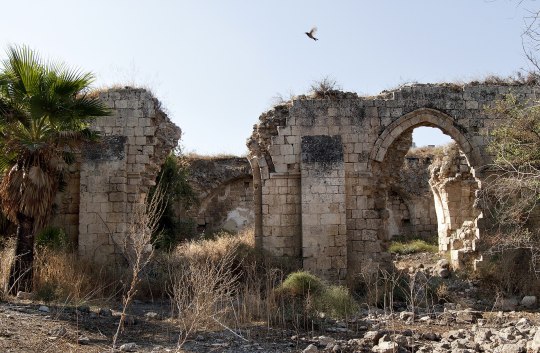
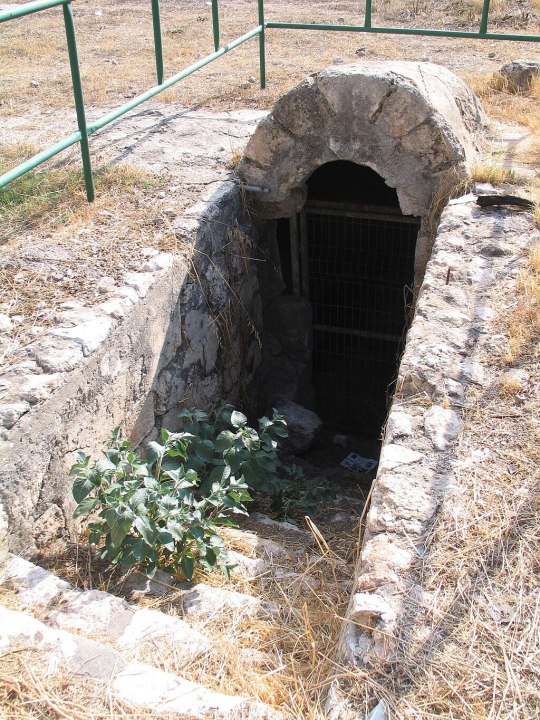

ruins of the white mosque of ramla, palestine. construction was initiated by umayyad governor sulayman ibn abd al-malik in 715-717 ce, but was completed by his successor umar ii in 720.
an earthquake in january of 1034 destroyed the mosque, and reconstruction was completed 200 years later. it since had several destructions, restorations, and expansions, including one restoration by saladin. the last took place between 1844-1918; since then, it has been mostly destroyed, with only its minaret still intact.
the mosque is reputable in muslim tradition; its minaret is referred to as the tower of forty martyrs, after the belief that forty companions of the prophet muhammad are buried under it. within local muslim tradition, it's believed that the prophet salih was also buried here, and a maqām in his honor is located nearby. a religious celebration of salih used to take place here annually before the nakba.
below the mosque's courtyard also exist three large cisterns (last two pictures) which provided water for worshippers, including for a former pool for wudu.
#palestine#architecture#worship#muslim#nakba#religious tombs#my posts#there's another maqām dedicated to salih in acre#also to clarify it’s been ruins since the earthquake#(i think)
271 notes
·
View notes
Text


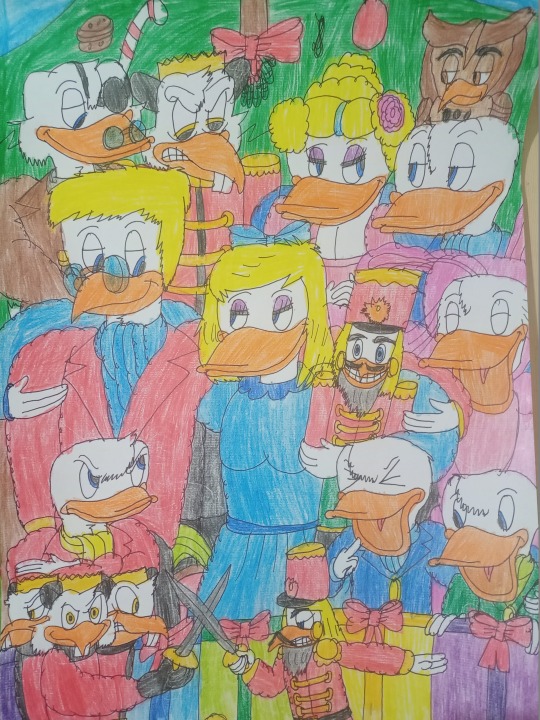

The Nutcracker in the Duckverse - Gyro Gearloose as Nutcracker and Drosselmeyer's nephew and Dickie Duck as Marie - Drawcember - Books, Music and Stories - Merry Christmas and Happy New Year - Cosplay, Ballet and Literature - Donald Duck Comics - Duckverse - My Style - A Gift for My Friends
This time I drew something related to cosplay from famous musical and literary works, and since the Christmas and New Year holidays are underway, I drew something related to one of my favorite Christmas works, which is the fairy tale about The Nutcracker. The Nutcracker is a fairy tale written by Ernst Theodor Amadeus Hoffmann in 1816 under the name "The Nutcracker and the Mouse King", and then the famous writer Alexandre Dumas wrote this into his story by publishing The Nutcracker in 1844. Many years later, in 1892, one of the best composers of all time, the Russian composer Pyotr Ilyich Tchaikovsky, composed it for a ballet called "The Nutcracker", which is why the Nutcracker is known to be the most famous and is mostly associated with Christmas stories.
It is about a German family Stahlbaum who celebrated Christmas Eve and Christmas and on that occasion their old friend Herr Drosselmeyer came and gave one of the Stahlbaum children, especially daughter Marie (in some versions Louise or Clara) a soldier who crunches nuts and nuts. That is why he was nicknamed The Nutcracker. Her brother Fritz broke the toy, which made Marie cry. Marie fell in love with him and one day an army of mice attacked their house, but the toy soldiers led by the Nutcracker managed to defend themselves. The Nutcracker defeated the king of mice who had seven heads. Then he took Marie to his kingdom of sweets and fairy tales and turned into a real prince. It was all just a dream, until on Christmas, Drosselmeyer's nephew came who looked a lot like a prince, which made Marie fall in love even more and they became friends and fell in love.
So I decided to draw this, only it stars the famous ducks from the Donald Duck comics. I wanted to draw Donald as the Nutcracker and Daisy as Marie, but for some reason I drew a different one with Gyro Gearloose as the Nutcracker and the nephew of Drosselmeyer and Dickie Duck as Marie. Gyro is a famous inventor from Duckburg, but it's very interesting that he's one of the toys and that Dickie saved him in the end and that they got married in the end. I love the two of them as a couple, so that's why I drew them in those roles. Donald's nephews Huey, Dewey and Louie Duck play the role of Marie's brother Fritz, and Donald and Daisy Duck play Marie's parents. Scrooge McDuck plays Herr Drosselmeyer since he likes to travel a lot, although he does it for his business. Fethry Duck is disguised as a rabbit because in that ballet the rabbit has a really good role, and at the end he added an owl who also has a role in that story. The main villain is the seven-headed mouse king played by Emil Eagle, one of the great villains from the Donald Duck comics and Gyro's greatest opponent. Yes, I drew the two of them sword fighting and fighting over Nutcracker's land. In the end, the Nutcracker won. I drew in my own style, using styles from Italian and European comics and I drew them wearing clothes from the 1820s, or rather from the 19th century, as they were worn then, since the story takes place then. Yes, there is a Mickey Mouse short from Mickey Mouse Works related to that topic, although I'm not a fan of Donald Duck playing the mouse king, and not Mortimer or Phantom Blot. So I drew my version more as I like it.
I hope you like this drawing and this idea and feel free to like and reblog this, just don't copy the same ideas without mentioning me. Thanks! Also, although it's been a while I wish a happy birthday to Dickie Duck who usually celebrates on December 18th every year so I wish her a happy birthday and sorry for the delay! Also this is a gift for my friend @flowervanband who loves this couple very much, as well as a gift for my friend @boingodigitalart, who had a hard time this year, but tried a lot with his drawings and managed to put everything together during the 366 days of this year. I hope you like it! Also I wish everyone a Merry Christmas and a Happy New Year!
Also this is dedicated to Drawcember since it is related to stories, books and music. And to @ace-of-garlic-breads. Also music for this: https://www.youtube.com/watch?v=C4wBG8BWbYg
#my fanart#the nutcracker#drawcember#duckverse#literature#christmas#merry christmas#happy new year#ducktales#donald duck#gyro gearloose#disney ducks#daisy duck#dickie duck#gyrie#tchaikovsky#duck comics#scrooge mcduck#huey dewey and louie#fethry duck#emil eagle#artists on tumblr#disney duckverse#gyro x dickie#topolino#huey dewey and louie duck#donald x daisy#gift for my friends#comics#cartoons
30 notes
·
View notes
Text
Under the 14th Amendment: “All persons born or naturalized in the United States, and subject to the jurisdiction thereof, are citizens of the United States and of the State wherein they reside.” This clause from 1868 has far surpassed its original intent. It has been abused as a method for citizenship by illegal migrants who often intentionally travel to the US to give birth, but not in the way the media portrays it. Recent data suggests at least 400,000 “anchor babies,” as they are called, were born in the US in 2024 alone.
The Common Law Doctrine of Jus Soli under English common law protected “right of the soil,” which deemed anyone born on a country’s soil to be a citizen. The US Constitution never clearly defined citizenship until the Naturalization Act of 1790, which granted citizenship to “free white persons” born on US soil. The advent of the Civil War left dire uncertainty for slaves who had no homeland to return to after the war came to an end and slavery was abolished. The 1844 case Lynch v Clarke in New York reaffirmed that anyone born to non-citizen parents would be considered an American. The Reconstruction Amendments remained vague, and Dred Scott was expanded in 1868 to include:
“All persons born or naturalized in the United States, and subject to the jurisdiction thereof, are citizens of the United States and of the State wherein they reside.”
The law remained open to interpretation. Native Americans, for example, were not seen as Americans since they did not pledge their allegiance to the federal government. It was not until the Indian Citizenship Act of 1924 that Native Americans were considered full citizens.
America’s complicated past with citizenship has led to today’s debacle. Nowhere along the way did the Supreme Court or any other entity grant citizenship to parents of children born in the US. However, the system often looks the other way to prevent separating families. American-born children may sponsor their parents for a green card when they turn 21. Then, the parents must wait five years before applying for naturalization. Parents often must leave the US for a decade before applying for citizenship. Yet, in recent years, we have seen people completely bypass the system by claiming asylum. Under Biden-Harris, the borders were simply wide open.
Hence why, the media is attacking incoming border tzar Tom Homan for insisting that families can leave the US together if they want to prevent separation. The parents are here illegally — plain and simple.
22 notes
·
View notes